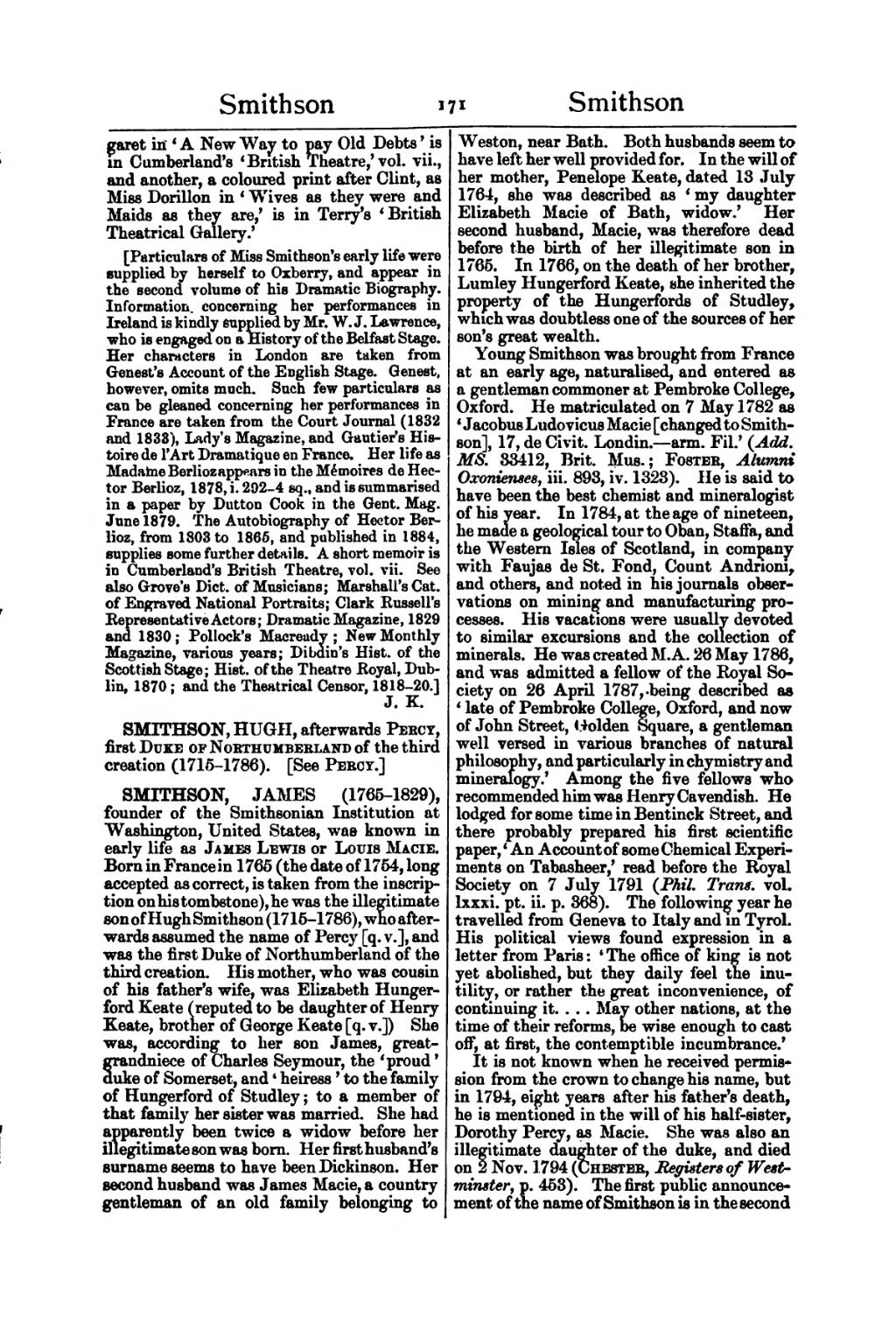garet in ‘A New Way to pay Old Debts’ is in Cumberland's ‘British Theatre,’ vol. vii., and another, a coloured print after Clint, as Miss Dorillon in ‘Wives as they were and Maids as they are,’ is in Terry's ‘British Theatrical Gallery.’
[Particulars of Miss Smithson's early life were supplied by herself to Oxberry, and appear in the second volume of his Dramatic Biography. Information concerning her performances in Ireland is kindly supplied by Mr. W. J. Lawrence, who is engaged on a History of the Belfast Stage. Her characters in London are taken from Genest's Account of the English Stage. Genest, however, omits much. Such few particulars as can be gleaned concerning her performances in France are taken from the Court Journal (1832 and 1833), Lady's Magazine, and Gautier's Histoire de l'Art Dramatique en France. Her life as Madame Berlioz appears in the Mémoires de Hector Berlioz, 1878, i. 292–4 sq., and is summarised in a paper by Dutton Cook in the Gent. Mag. June 1879. The Autobiography of Hector Berlioz, from 1803 to 1865, and published in 1884, supplies some further details. A short memoir is in Cumberland's British Theatre, vol. vii. See also Grove's Dict. of Musicians; Marshall's Cat. of Engraved National Portraits; Clark Russell's Representative Actors; Dramatic Magazine, 1829 and 1830; Pollock's Macready; New Monthly Magazine, various years; Dibdin's Hist. of the Scottish Stage; Hist. of the Theatre Royal, Dublin, 1870; and the Theatrical Censor, 1818–20.]
SMITHSON, HUGH, afterwards Percy, first Duke of Northumberland of the third creation (1715-1786). [See Percy.]
SMITHSON, JAMES (1765–1829), founder of the Smithsonian Institution at Washington, United States, was known in early life as James Lewis or Louis Macie. Born in France in 1765 (the date of 1754, long accepted as correct, is taken from the inscription on his tombstone), he was the illegitimate son of Hugh Smithson (1715–1786), who afterwards assumed the name of Percy [q. v.], and was the first Duke of Northumberland of the third creation. His mother, who was cousin of his father's wife, was Elizabeth Hungerford Keate (reputed to be daughter of Henry Keate, uncle of George Keate [q. v.]). She was, according to her son James, great-grandniece of Charles Seymour, the ‘proud’ duke of Somerset, and ‘heiress’ to the family of Hungerford of Studley; to a member of that family her sister was married. She had apparently been twice a widow before her illegitimate son was born. Her first husband's surname seems to have been Dickinson. Her second husband was James Macie, a country gentleman of an old family belonging to Weston, near Bath. Both husbands seem to have left her well provided for. In the will of her mother, Penelope Keate, dated 13 July 1764, she was described as ‘my daughter Elizabeth Macie of Bath, widow.’ Her second husband, Macie, was therefore dead before the birth of her illegitimate son in 1765. In 1766, on the death of her brother, Lumley Hungerford Keate, she inherited the property of the Hungerfords of Studley, which was doubtless one of the sources of her son's great wealth.
Young Smithson was brought from France at an early age, naturalised, and entered as a gentleman commoner at Pembroke College, Oxford. He matriculated on 7 May 1782 as ‘Jacobus Ludovicus Macie [changed to Smithson], 17, de Civit. Londin.—arm. Fil.’ (Add. MS. 33412, Brit. Mus.; Foster, Alumni Oxonienses, iii. 893, iv. 1323). He is said to have been the best chemist and mineralogist of his year. In 1784, at the age of nineteen, he made a geological tour to Oban, Staffa, and the Western Isles of Scotland, in company with Faujas de St. Fond, Count Andrioni, and others, and noted in his journals observations on mining and manufacturing processes. His vacations were usually devoted to similar excursions and the collection of minerals. He was created M.A. 26 May 1786, and was admitted a fellow of the Royal Society on 26 April 1787, being described as ‘late of Pembroke College, Oxford, and now of John Street, Golden Square, a gentleman well versed in various branches of natural philosophy, and particularly in chymistry and mineralogy.’ Among the five fellows who recommended him was Henry Cavendish. He lodged for some time in Bentinck Street, and there probably prepared his first scientific paper, ‘An Account of some Chemical Experiments on Tabasheer,’ read before the Royal Society on 7 July 1791 (Phil. Trans. vol. lxxxi. pt. ii. p. 368). The following year he travelled from Geneva to Italy and in Tyrol. His political views found expression in a letter from Paris: ‘The office of king is not yet abolished, but they daily feel the inutility, or rather the great inconvenience, of continuing it. … May other nations, at the time of their reforms, be wise enough to cast off, at first, the contemptible incumbrance.’
It is not known when he received permission from the crown to change his name, but in 1794, eight years after his father's death, he is mentioned in the will of his half-sister, Dorothy Percy, as Macie. She was also an illegitimate daughter of the duke, and died on 2 Nov. 1794 (Chester, Registers of Westminster, p. 453). The first public announcement of the name of Smithson is in the second
